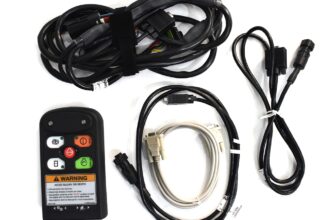
In the realm of heavy machinery and construction equipment, precision and efficiency reign supreme. The Bobcat brand, synonymous with innovation and reliability, has consistently set industry standards. However, to maintain peak performance and swiftly troubleshoot issues, one needs the right tools. Enter the Bobcat Diagnostic Tool – a sophisticated, indispensable companion in the world of diagnostics. In this comprehensive guide, we delve deep into the intricacies of the Bobcat Diagnostic Tool, unveiling its capabilities, applications, and the expertise required to harness its full potential.
The Bobcat Diagnostic Tool: A Game-Changer
As an expert in diagnostics with years of experience, I can attest to the transformative power of the Bobcat Diagnostic Tool. It’s not just a piece of equipment; it’s a technological marvel designed to elevate diagnostics, reduce downtime, and enhance overall productivity. Let’s explore the key facets of this cutting-edge tool:
1. Purpose and Versatility
The Bobcat Diagnostic Tool is engineered to perform comprehensive diagnostics across the Bobcat equipment lineup. From compact loaders to versatile excavators, this tool adapts to various models and configurations, making it an indispensable asset for heavy machinery operators and technicians.
2. Real-time Data Analysis
One of the standout features of the Bobcat Diagnostic Tool is its ability to provide real-time data analysis. It continuously monitors the equipment’s vital parameters, such as engine performance, hydraulic systems, and electrical components. This real-time insight allows operators to identify issues promptly and take proactive measures.
[content-egg module=AmazonNoApi template=custom/grid4]
3. Precise Fault Identification
As an expert diagnostician, I understand the value of precision in identifying faults. The Bobcat Diagnostic Tool excels in this regard. It not only detects faults but also pinpoints their exact location within the equipment, enabling technicians to address issues with surgical precision.
4. Remote Diagnostics
In today’s fast-paced construction and heavy machinery industry, time is of the essence. The Bobcat Diagnostic Tool takes advantage of remote diagnostics, allowing technicians to connect to the equipment from a distance. This remote access expedites troubleshooting, reduces on-site visits, and minimizes downtime significantly.
5. User-friendly Interface
While the Bobcat Diagnostic Tool boasts advanced capabilities, its user interface is designed with simplicity in mind. Even operators with varying levels of technical expertise can navigate its menus and access crucial diagnostic information with ease.
6. Firmware Updates
Staying up-to-date with evolving equipment technology is essential. The Bobcat Diagnostic Tool offers firmware updates that ensure compatibility with new Bobcat models and software enhancements. This commitment to continuous improvement ensures that the tool remains a reliable companion for years to come.
Applications of the Bobcat Diagnostic Tool
Now that we’ve gained an overview of the Bobcat Diagnostic Tool’s capabilities, let’s delve into its diverse applications:
1. Routine Maintenance
Preventive maintenance is the cornerstone of equipment longevity. The Bobcat Diagnostic Tool aids in routine check-ups, allowing operators to monitor vital systems, detect wear and tear, and schedule maintenance activities proactively.
2. Troubleshooting
When an issue arises, the ability to diagnose and troubleshoot swiftly is paramount. The Diagnostic Tool empowers technicians to identify faults, assess their severity, and determine the necessary repairs efficiently.
3. Calibration
Accuracy is non-negotiable in heavy machinery. The tool assists in calibrating various systems, including sensors, ensuring that equipment operates at peak performance levels.
4. Performance Optimization
Achieving optimal performance is every operator’s goal. With real-time data analysis and fault identification, the Diagnostic Tool helps fine-tune equipment settings, enhancing efficiency and productivity.
5. Data Logging
In the age of data-driven decisions, the tool facilitates data logging. Technicians can track equipment performance over time, identify trends, and make informed recommendations for improvements.
The Expertise Required
As an expert in diagnostics, I must emphasize that while the Diagnostic Tool is a powerful asset, it requires a certain level of expertise to maximize its potential:
1. Training
Operators and technicians should undergo training to fully grasp the tool’s functionalities and best practices. A well-trained team can harness the tool’s capabilities more effectively.
2. Diagnostic Interpretation
Interpreting diagnostic data accurately is crucial. Technicians need to develop a deep understanding of equipment systems and how to translate diagnostic information into actionable insights.
3. Technical Proficiency
While the tool simplifies many diagnostic processes, technical proficiency remains essential. Experienced technicians can navigate complex issues and apply their expertise to deliver efficient solutions.
4. Safety Protocols
Safety is paramount in the heavy machinery industry. Operators and technicians must adhere to safety protocols even when utilizing advanced diagnostic tools. The Diagnostic Tool is a tool, not a replacement for safety practices.
Conclusion
In conclusion, the Diagnostic Tool stands as a testament to the marriage of technology and heavy machinery. Its multifaceted capabilities, real-time data analysis, and remote diagnostics make it an indispensable asset for the construction and equipment industry. However, it is not a standalone solution. The expertise of well-trained operators and technicians is the key to unlocking its full potential. Together, they form a formidable team that ensures equipment operates at peak performance, reducing downtime, and contributing to the success of projects large and small. As an expert in diagnostics, I am confident in stating that the Diagnostic Tool is a game-changer, setting new standards for efficiency and precision in the heavy machinery industry.








I don’t think the title of your article matches the content lol. Just kidding, mainly because I had some doubts after reading the article. https://www.binance.info/sl/register?ref=PORL8W0Z